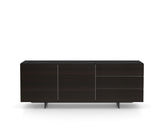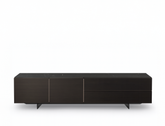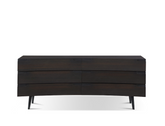Leather Types and Grades Explained

Leather is a timeless and versatile material that is highly prized in both the fashion and interior design industries. Known for its luxurious appearance, durability, and comfort, genuine leather is often considered a premium choice for furniture. However, not all leather is created equal, and understanding the different grades of leather can significantly impact your furniture-buying decisions. This guide will explore the various types of leather, their benefits, and how to choose the perfect leather material for your furniture.
Understanding Leather: Why It’s a Popular Choice for Furniture
Leather is a natural upholstery material derived from the skin or hide of animals, most commonly cows. The quality of leather varies depending on the type of animal, the specific area of the hide used, and the processing techniques employed. Cowhide is particularly popular for making luxurious leather due to its durability and versatility. Leather is a preferred choice for furniture because it is easy to maintain, resistant to wear and tear, and adds an element of sophistication to any room.
The process of turning raw animal hide into durable leather involves several stages, including preparation, soaking, tanning, and crusting. Tanning, the most crucial step, stabilizes the protein content in the hide, preventing it from decomposing and making it supple and long-lasting.
The Benefits of Choosing Genuine Leather for Your Furniture
When investing in furniture, genuine leather is often a top choice for those who value quality, durability, and timeless appeal. Here are some reasons why genuine leather is a superior option:
Exceptional Durability: Genuine leather is renowned for its longevity. Unlike other upholstery materials, leather can withstand years of use without significant signs of wear. It is resistant to spills and stains, making it an ideal choice for households with children or pets.
Timeless Aesthetic: Leather furniture exudes a classic elegance that never goes out of style. Over time, genuine leather develops a unique patina, a natural sheen that enhances its appearance and adds character. Whether you prefer a traditional or modern aesthetic, leather furniture can seamlessly complement any interior design theme.
Superior Comfort: One of the most appealing aspects of genuine leather is its comfort. Leather adapts to body temperature, providing a comfortable seating experience in any season. Additionally, leather furniture retains its shape and structure over time, ensuring that your investment remains comfortable for years to come.
Types of Leather Used in Furniture Manufacturing
When shopping for leather furniture, it is essential to understand the different types of leather available. Each type varies in quality, texture, and price, which can influence your buying decision.
Full-Grain Leather: The Pinnacle of Quality
Full-grain leather is the highest quality leather available, prized for its durability and natural beauty. This type of leather is made from the top layer of the hide, retaining all the natural grain and imperfections, such as scars and blemishes. These characteristics add to the leather’s unique appeal, giving it a rugged, organic look that softens over time.
The tanning process for full-grain leather is relatively simple, often using natural vegetable dyes that preserve the leather's texture and integrity. As full-grain leather ages, it develops a patina—a thin protective layer that enhances the leather's appearance and durability.
Full-grain leather is available in two main types: aniline and semi-aniline. Aniline leather is dyed using soluble dyes that do not obscure the natural grain, resulting in a rich, natural color. However, it lacks a protective coating, making it more susceptible to stains and wear. Semi-aniline leather, on the other hand, has a light protective coating, which provides some resistance to stains while retaining the natural look of the leather.
Top-Grain Leather: A Softer, More Uniform Option
Top-grain leather is another popular choice for furniture, known for its smooth texture and consistent appearance. Unlike full-grain leather, top-grain leather is sanded or buffed to remove imperfections from the surface, making it thinner and more pliable. This process also makes top-grain leather less durable than full-grain leather, but it is still a high-quality material that offers a balance between aesthetics and practicality.
Top-grain leather is typically used in high-end furniture due to its refined appearance and soft feel. It is often treated with pigments and finishes to create a uniform color and texture, which enhances its resistance to stains and scratches.
Split-Grain Leather: A Budget-Friendly Alternative
Split-grain leather is made from the lower layers of the hide after the top layer has been removed. This type of leather is more affordable than full-grain or top-grain leather, but it is also less durable and has a more artificial appearance. Split-grain leather is often heavily pigmented to cover imperfections, resulting in a more uniform look but less natural texture.
While split-grain leather may not have the same longevity as higher-quality leathers, it is still a viable option for those looking for the look and feel of leather on a budget.
Bonded Leather: The Eco-Friendly Choice
Bonded leather is made from scraps of leather that are bonded together using adhesives and then coated with a synthetic material to mimic the appearance of genuine leather. While bonded leather is not as durable or luxurious as full-grain or top-grain leather, it is an affordable and eco-friendly option that still offers the aesthetic appeal of leather.
Bonded leather is often used in budget-friendly furniture and accessories, making it a popular choice for those who want the look of leather without the high price tag.
Faux Leather: A Vegan-Friendly Option
Faux leather, also known as synthetic leather, is a man-made material designed to replicate the look and feel of genuine leather. Made from a combination of fabric and PVC or polyurethane, faux leather is a durable and low-maintenance alternative to animal-based leather. It is also an excellent choice for those who prefer not to use animal products in their home decor.
Faux leather is available in a wide range of colors and textures, making it a versatile option for furniture upholstery. While it may not have the same natural appeal as genuine leather, faux leather is a practical and affordable choice for those who want a leather-like appearance.
Choosing the Perfect Leather Material for Your Furniture
Leather is a popular material for a wide range of furniture, from sofas and chairs to beds and storage pieces. When selecting leather furniture, it is important to consider both the quality of the leather and the overall design of the piece.
Determine Your Needs: Before purchasing leather furniture, think about how the piece will be used. For example, if you need a durable sofa for a busy household, full-grain leather might be the best choice due to its toughness and ability to age gracefully. On the other hand, if you are looking for a stylish accent chair, top-grain leather offers a softer, more refined appearance.
Consider Your Budget: Leather furniture can vary greatly in price depending on the type of leather used. Full-grain and top-grain leathers are typically more expensive, but they offer superior quality and longevity. If you are on a budget, split-grain, bonded, or faux leather may be more affordable options that still provide a leather-like look.
Match Your Style: Leather furniture comes in various colors and finishes, so choose a piece that complements your existing decor. Whether you prefer a classic, rustic look or a sleek, modern design, there is a leather option to suit your taste.
Assess Comfort and Support: In addition to the leather quality, consider the structure and support of the furniture. Look for pieces with sturdy frames and comfortable cushioning to ensure that your furniture is not only beautiful but also functional.
FAQs About Leather Furniture
- What is the difference between full-grain and top-grain leather?
Full-grain leather is made from the top layer of the hide and retains all the natural grain and imperfections, making it the highest quality and most durable leather. Top-grain leather, on the other hand, is sanded and buffed to remove imperfections, resulting in a smoother and more uniform appearance. While both are high-quality leathers, full-grain leather is more natural and rugged, while top-grain leather is softer and more refined.
- Is leather furniture worth the investment?
Yes, leather furniture is worth the investment due to its durability, timeless appeal, and comfort. Genuine leather can last for many years with proper care, making it a cost-effective choice in the long run. Additionally, leather furniture adds a touch of luxury and sophistication to any space, enhancing the overall aesthetic of your home.
- How do I care for leather furniture?
To care for leather furniture, regularly dust and vacuum to remove dirt and debris. Use a damp cloth to wipe away spills and stains, and avoid using harsh chemicals or cleaning products that can damage the leather. To maintain the leather’s suppleness, apply a leather conditioner every six to twelve months. Keep leather furniture away from direct sunlight and heat sources to prevent fading and drying.
- Can faux leather be a good alternative to genuine leather?
Faux leather can be a good alternative to genuine leather for those who prefer a vegan-friendly option or are on a budget. While it does not have the same natural look and feel as genuine leather, faux leather is durable, easy to maintain, and available in various styles. It is a practical choice for furniture that will see heavy use or for households with young children or pets.
- How can I tell if a piece of furniture is made from genuine leather?
To determine if a piece of furniture is made from genuine leather, check for natural imperfections, such as scars, wrinkles, or color variations, which indicate that the leather is real. Genuine leather also has a distinct smell, unlike synthetic materials. Additionally, the texture of genuine leather is soft and warm to the touch, whereas faux leather often feels cooler and more rigid.
- What is bonded leather, and how does it compare to other types of leather?
Bonded leather is made from leather scraps that are bonded together and coated with a synthetic material to create a leather-like appearance. While bonded leather is more affordable than full-grain or top-grain leather, it is also less durable and may wear out more quickly. However, it is a budget-friendly option for those who want the look of leather without the high cost.
Conclusion
Leather furniture is a worthwhile investment that combines beauty, comfort, and durability. By understanding the different types of leather and their unique qualities, you can make an informed decision when purchasing leather furniture. Whether you choose full-grain, top-grain, split-grain, bonded, or faux leather, selecting the right material will ensure that your furniture enhances your home for years to come.
If you're looking for elegant leather furniture in Singapore, check out Prestige Affairs extensive collection of leather sofas, faux leather sofas, leather bed frames, and chairs to find what's best for you.







